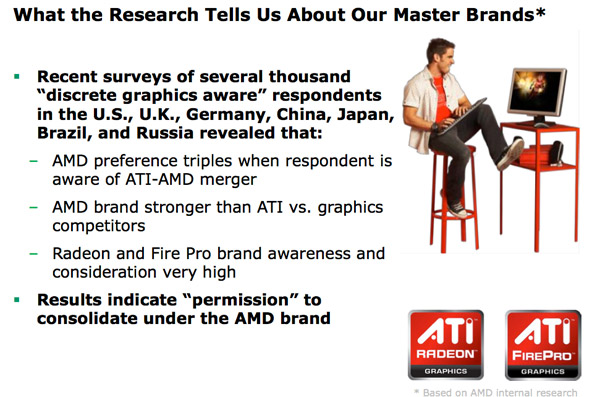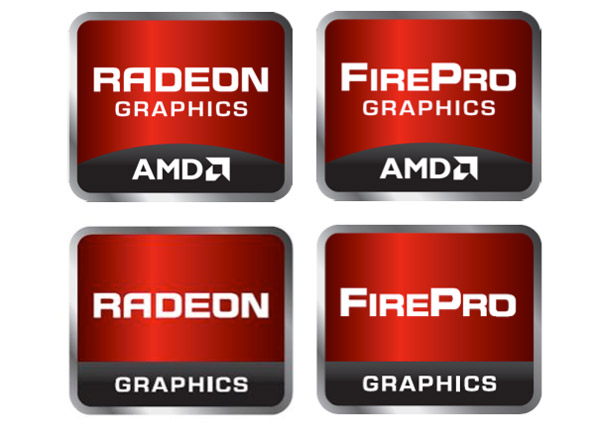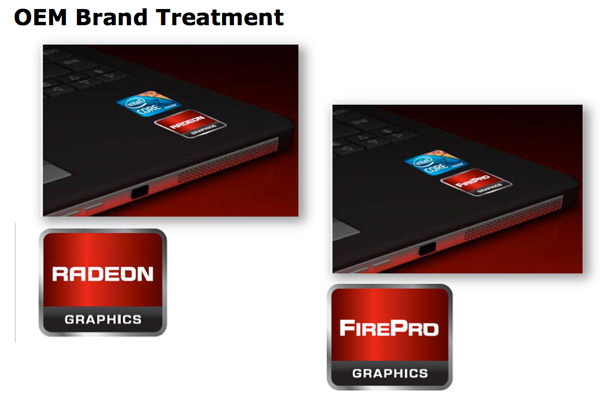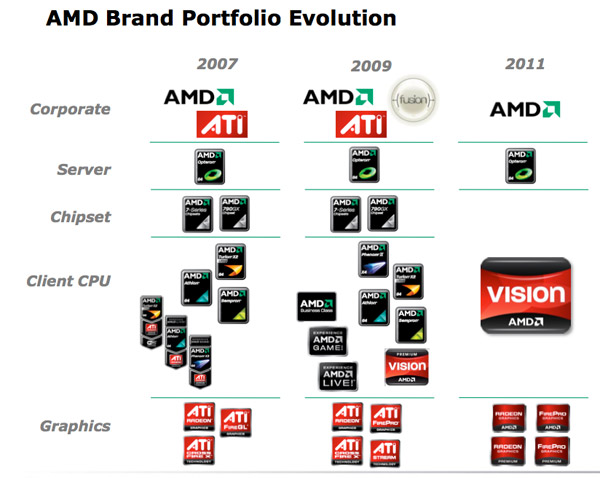Farewell to ATI, AMD to Retire the ATI Brand Later this Year
by Anand Lal Shimpi on August 30, 2010 12:02 AM ESTFour years ago AMD did the unthinkable: it announced the 5.4 billion dollar acquisition of ATI in a combination of cash and stock. What followed was a handful of very difficult years for AMD, an upward swing for ATI and the eventual spinoff of AMD’s manufacturing facilities to GlobalFoundries in order to remain profitable and competitive.
In the years post acquisition, many criticized AMD for blowing a lot of money on ATI and having little to show for it. Even I felt that for $5.4 billion AMD could’ve put together its own competent graphics and chipset teams.
Despite the protest and sideline evaluations, good has come from the acquisition. The most noticeable is the fact that AMD’s chipset business is the strongest it has ever been. AMD branded chipsets and integrated graphics are actually very good. And later this year, AMD will ship its first Fusion APUs (single die CPU/GPU): Ontario using Bobcat cores and an AMD GPU. Ontario will be the first tangible example of direct AMD/ATI collaboration since the acquisition.
Just as we’re about to see results from the acquisition AMD is announcing that it will retire the ATI brand later this year. Save those boxes guys, soon you won’t see an ATI logo on any product sold in the market.

The motivation behind the decision to retire the ATI brand comes from AMD’s own internal research. Unfortunately AMD isn’t sharing the details of this research, just the three major findings from it:
1) AMD brand preference triples when the person surveyed is aware of the ATI-AMD merger.
2) The AMD brand is viewed as stronger than ATI when compared to graphics competitors (presumably NVIDIA).
3) The Radeon and Fire Pro brands themselves (without ATI being attached to them) are very high as is.
The second point is really the justification for all of this. If AMD’s internal research is to be believed, AMD vs. NVIDIA is better from a marketing standpoint than ATI vs. NVIDIA. Honestly, AMD’s research seems believable. AMD has always seemed like a stronger brand to me than ATI. There’s little room for ego in business (despite it being flexed all too often) and I don’t believe AMD would hurt its marketing simply to satisfy any AMD executives - the research makes sense.
Meanwhile the third point is the realization that there are very few product lines with the ATI brand left. ATI's chipset operations were quickly absorbed in to AMD and given appropriate naming, while ATI's consumer electronics products such as their Digital TV division have been sold to other companies. Radeon and FirePro are the only two ATI product lines left, and both are strong brands on their own.
The brand switch also reflects some internal changes at AMD. Many important ATI employees have been relocated to AMD's base of operations in Austin, Texas in order to help with Liano, Ontario, and AMD's future Fusion products. So the line between AMD and ATI has been further blurring for some time.
The brand switch will start late this year, I’d guess in Q4 with Ontario and a new GPU release. AMD (and NVIDIA) originally had GPU designs for the 32nm process node however extensive teething problems with 40nm and 32nm forced TSMC to cancel the node and move directly to 28nm. This cancellation required both companies to redesign their parts to work within existing 40nm processes and move their original plans out to coincide with 28nm in 2011. As a result we will see an incremental update to the Radeon HD 5000 series at the end of this year, but don’t expect the sort of performance boost we got with the 5800 vs. 4800. This upcoming hardware will probably carry the AMD Radeon HD 6000 series brand. All existing hardware will continue to carry the ATI brand.
To go along with the new brand we get new logos. If OEMs want to display a badge without the AMD brand, there’s an alternative for that as well:

AMD states the AMD-less logos are purely at the request of OEMs who sell systems with Intel CPUs and AMD GPUs. I suspect Intel’s logo program may have some stipulations on being used adjacent to a sticker with an AMD logo on it, although AMD told me it was purely at the request of the OEMs trying to avoid confusion.

The other major change is AMD’s brand simplification at the retail level. Last year AMD introduced a new platform brand called Vision. If you buy a PC with all AMD components (CPU, chipset and GPU) it can carry a Vision logo (similar to Intel’s Centrino brand). There are four categories of Vision support all with increasing hardware requirements: Vision, Vision Premium, Vision Ultimate and Vision Black. The idea is that if you buy a standard Vision PC you’ll have a good entry level machine, but buying up the stack grants you additional capabilities and performance (e.g. Blu-ray playback, web cam support, discrete GPUs, multicore CPUs etc...). We’ve explained it all in greater detail here.
Starting next year, AMD’s Vision badge will be the only CPU brand you see on retail desktops/notebooks. You’ll still get Radeon/Fire Pro badges on systems that use those parts, but you’ll no longer see a Phenom II, Athlon II, Turion or Sempron logo on Vision systems. Instead you’ll see what CPU is inside on the little card that sits next to the system at your local retailer.

I suspect this will last until AMD introduces Bulldozer, at which point it’ll probably be very eager to build up its brand - assuming performance its is competitive.
Final Words
Retiring the ATI brand comes at an interesting time in the microprocessor market. Graphics is becoming much more important, but to date we have very few examples outside of 3D games as good consumer applications for powerful GPUs. AMD views this as the perfect time to consolidate its brands before the CPU/GPU line gets more blurry.

AMD also pointed out that its market share has been on a steady climb over the past few years. According to Mercury Research, AMD’s discrete GPUs climbed from ~33% marketshare at the end of 2007 to 51% last quarter. AMD has executed unusually well on the GPU side and NVIDIA has had some very difficult years in the process, both of which are responsible for AMD’s climb. The ATI name will go out on a high note.

AMD Discrete GPU Marketshare, Source: Mercury Research
If all goes well with AMD’s two exciting new CPU architectures next year, the brand will only get stronger going forward. Bobcat could do very well in today’s netbook/thin and light notebook form factors and Bulldozer may mark a return to competition in the server and high end desktop markets.










80 Comments
View All Comments
dingetje - Tuesday, August 31, 2010 - link
VESA Local Bus ftw !!lolz
softdrinkviking - Tuesday, August 31, 2010 - link
i think the et4000 was actually an ATI chipset. tseng just did the PCB and integration, ect. like buying an extremely redesigned radeon card today. there may have been some other secret sauce, but I'm pretty sure tseng was not the semi designer, just the one who put the stuff together.Rankor - Tuesday, August 31, 2010 - link
I came to the game with an et6000. That card screamed back then. Hooked that with a Diamond Monster 3Dfx Voodoo 1 via the passthrough cable and it was unbeatable!SandmanWN - Monday, August 30, 2010 - link
Seems like a mistake to me. You have AMD CPU's, ATI Graphics, and Fusion combo, so after this everything is some derivative of an AMD logo.Makes it much more confusing for people who don't know much about computers and are looking for the same ATI sticker on a new laptop to match up to an older model they are replacing.
Not to mention having another name gives you an escape goat if you ever make a product that fails and causes you bad publicity. Thats when you switch names.
bji - Monday, August 30, 2010 - link
Ha ha! That's a new one!blyndy - Monday, August 30, 2010 - link
Intel hates AMD news. There will be some incoming Intel news very soon to drown out the AMD news :-Dsilverblue - Monday, August 30, 2010 - link
Care to share?vol7ron - Monday, August 30, 2010 - link
I think this was speculative, but each company has so much going on, it's up to their marketing on whether to saturated the media.My guess is that there is some SSD news on the way, though.
Sabbathian - Monday, August 30, 2010 - link
Good old times... me any my S3 Virge.... paired with Voodoo 1 .... those were the times... 12 MB of RAM on both cards together.... and now... I have 768 MB on one card! Darn ... I was happy when I got 64MB of RAM in those times :)... 4 GB now :)Now when I buy something new... there is no excitement like there were before... is it me or ?
MonkeyPaw - Monday, August 30, 2010 - link
It's hard because back then, an upgrade was usually a pretty substantial gain, and games really started to improve drastically with technology advances (like Quake to Q2 to Q3). Now an upgrade generation may make some games look a little better or run at a higher res, but those games were perfectly playable on what you had. Heck, an upgrade then used to even help make Windows faster. Hardly a problem today.